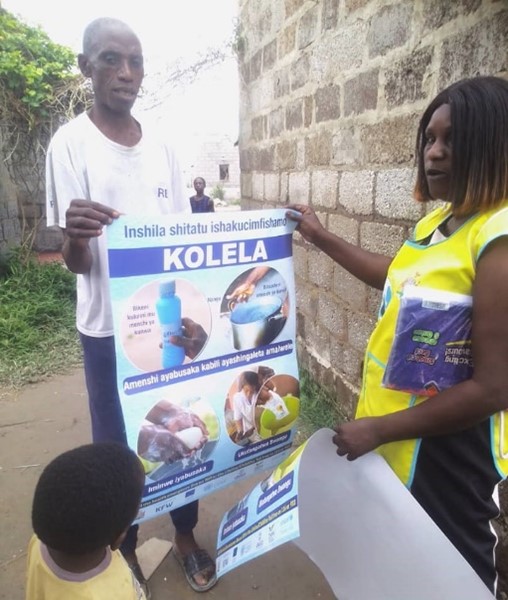
The UK Health Security Agency (UKHSA) International Health Regulations Strengthening Project (IHR-SP) in partnership with the Zambia National Public Health Institute (ZNPHI), International Federation of the Red Cross - Cholera Support Platform (IFRC-CSP), and the Ministry of Health, conducted training in Case Area Targeted Interventions (CATI) for cholera control in Lusaka.
The training aimed to enhance the cholera preparedness and response capacity of Rapid Response Teams (RRTs) and Community-Based Volunteers (CBVs) by equipping them with knowledge and skills to rapidly contain cholera outbreaks in affected areas.
CATI can be applied across different disease outbreaks and is used to:
- Identify areas with high risks of disease outbreaks, like cholera
- Target specific interventions such as community hygiene kit distribution, hygiene promotion and education and water treatment
- Implement and monitor those interventions to prevent or control disease outbreaks.
Lusaka has a history of recurrent cholera outbreaks due to rapid urban growth, resulting in overcrowding and inadequate sanitation infrastructure. These factors, compounded by contaminated water sources and poor sanitation practices, significantly contribute to cholera transmission among residents. Neighbouring provinces have experienced recent or ongoing outbreaks of cholera and the risk of it spreading to Lusaka and other parts of the country is considered to be high.
CATI is based on the principle that the early detection of cholera cases can trigger a rapid, localised response in a 150m high-risk radius around one or more case-households where people at the highest risk of infection live. This can reduce transmission sufficiently to contain the outbreak or reduce its spread. CATI is a part of Zambia’s cholera preparedness and response strategy and has been incorporated into updated national cholera guidelines, with contributions from UKHSA IHR-SP.
Held in February 2025, the training drew 95 healthcare workers and community-based volunteers from Lusaka sub-districts which are high risk areas for cholera and floods, namely Kanyama, Mandevu, Lusaka Central and Chawama. It followed on from a national CATI Trainer of Trainers in November 2024.
Across four days, participants were trained in how to:
- Understand the strategic use of CATI to control outbreaks including how it fits into Zambia’s cholera preparedness and response plan at district level
- Describe the roles and responsibilities of various stakeholders in the implementation of CATI
- Identify the key components of cholera CATI, including
- Surveillance requirements for early case detection
- Health promotion through CBVs
- Risk Communication and Community Engagement
- Community water, sanitation, and hygiene (WASH) interventions, and
- targeted Oral Cholera vaccination
- To learn the decision criteria of when to start and stop CATI and move to cluster or mass interventions
- Identify and prepare logistics for hotspot areas for CATI.
Feedback from participants showed a strong understanding of CATI’s integration into emergency plans, with 98% of respondents reporting confidence in their roles and responsibilities within CATI and 82% strongly agreeing on the importance of the training. One participant highlighted the training's impact: “The knowledge obtained will be used to my benefit and that of the people in my community e.g., educating on health promotion.” The feedback represents a response rate of 53% (50 from the 95 participants trained). The low response rate was attributed to the majority of CBV’s not having smartphones that were compatible with the survey link, presenting a challenge for them to fill out the survey form.
A week after the training concluded, on 1 March 2025 Kanyama sub district in Lusaka recorded three culture confirmed cholera cases. The CATI teams were deployed into the community within 24 hours with hygiene kits and other enablers. A total of 814 households and 4,475 individuals in the CATI ring were reached. The outbreak in Lusaka has been contained and the CATI strategy has been instrumental in effectively curbing the spread of cholera.
The CATI training, co-supported with funding from the Foreign Commonwealth and Development Office, showcased a unified one-HMG working approach, leveraging technical expertise from IHR-SP in strengthening health systems. Next steps include rolling out CATI training to other districts in the country, especially those identified for Priority Area Multisectoral Interventions (PAMIs) for cholera control previously called hotspots.
Useful Resources
Related Articles
-
From vision to action: Sindh’s IDSR Lab Network Review marks key progress in Pakistan’s IDSR journey
BY Dr Muhammad Sartaj -
Gilgit-Baltistan launches new laboratory network in efforts to strengthen Integrated Disease Surveillance and Response across Pakistan
BY Dr Muhammad Sartaj, Sumera Abid -
Building a stronger health partnership with academic institutions for strengthening IHR in Pakistan: IDSR training for Master Trainers at The Institute of Public Health, Lahore
BY Dr Muhammad Sartaj -
Pioneering training on “District Health Information System-2” to strengthen Integrated Disease Surveillance and Response System in laboratories in Sindh province of Pakistan
BY IHR -
First-of-its-kind Community-Based Surveillance Training in Mardan to Boost Pakistan’s Disease Preparedness and response
BY Najma, Mirza Zeeshan Iqbal Baig, Nadia Nisar, Dr Muhammad Sartaj


Please Sign in (or Register) to view further.